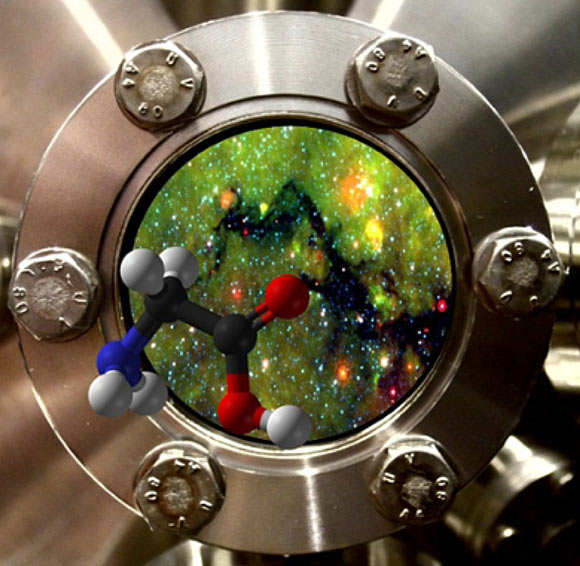Glycine and other amino acids form in dense interstellar clouds well before they transform into new stars and planets, suggests a new study led by researchers at Queen Mary University of London and Leiden Observatory.

An artist’s impression of glycine together with dark interstellar clouds in the lab. Image credit: Harold Linnartz.
The unraveling of the formation and distribution of complex organic molecules in space is key to our understanding of the initial conditions for the emergence of life on Earth.
Glycine, the simplest amino acid, its amine precursor methylamine, and other organic compounds were recently detected in the coma of comets such as Wild 2 by NASA’s Stardust mission and 67P/Churyumov-Gerasimenko by ESA’s Rosetta mission.
There is strong evidence that comets are the most primitive planetary bodies in our Solar System and that organic molecules present in their ices have an interstellar origin.
How and when such complex molecules form along the process of star- and planet-formation remains debated.
In a new study, Dr. Sergio Ioppolo from Queen Mary University of London and colleagues show that it is possible for glycine to form on the surface of icy dust grains, in the absence of energy, through ‘dark chemistry.’
“Dark chemistry refers to chemistry without the need of energetic radiation,” Dr. Ioppolo said.
“In the laboratory we were able to simulate the conditions in dark interstellar clouds where cold dust particles are covered by thin layers of ice and subsequently processed by impacting atoms causing precursor species to fragment and reactive intermediates to recombine.”
Dr. Ioppolo and co-authors first showed methylamine, the precursor of glycine, could form.
Then, using a unique ultra-high vacuum setup, equipped with a series of atomic beam lines and accurate diagnostic tools, the researchers were able to confirm glycine could also be formed, and that the presence of water ice was essential in this process.
Further investigation using astrochemical models confirmed the experimental results and allowed the team to extrapolate data obtained on a typical laboratory timescale of just one day to interstellar conditions, bridging millions of years.
“From this we find that low but substantial amounts of glycine can be formed in space with time,” said co-author Professor Herma Cuppen, a scientist at Radboud University.
“The important conclusion from this work is that molecules that are considered building blocks of life already form at a stage that is well before the start of star and planet formation,” said senior author Dr. Harold Linnartz, Director of the Laboratory for Astrophysics at Leiden Observatory.
“Such an early formation of glycine in the evolution of star-forming regions implies that this amino acid can be formed more ubiquitously in space and is preserved in the bulk of ice before inclusion in comets and planetesimals that make up the material from which ultimately planets are made.”
“Once formed, glycine can also become a precursor to other complex organic molecules,” Dr. Ioppolo said.
“Following the same mechanism, in principle, other functional groups can be added to the glycine backbone, resulting in the formation of other amino acids, such as alanine and serine in dark clouds in space.”
“In the end, this enriched organic molecular inventory is included in celestial bodies, like comets, and delivered to young planets, as happened to our Earth and many other planets.”
The results appear this week in the journal Nature Astronomy.
_____
S. Ioppolo et al. A non-energetic mechanism for glycine formation in the interstellar medium. Nat Astron, published online November 16, 2020; doi: 10.1038/s41550-020-01249-0







